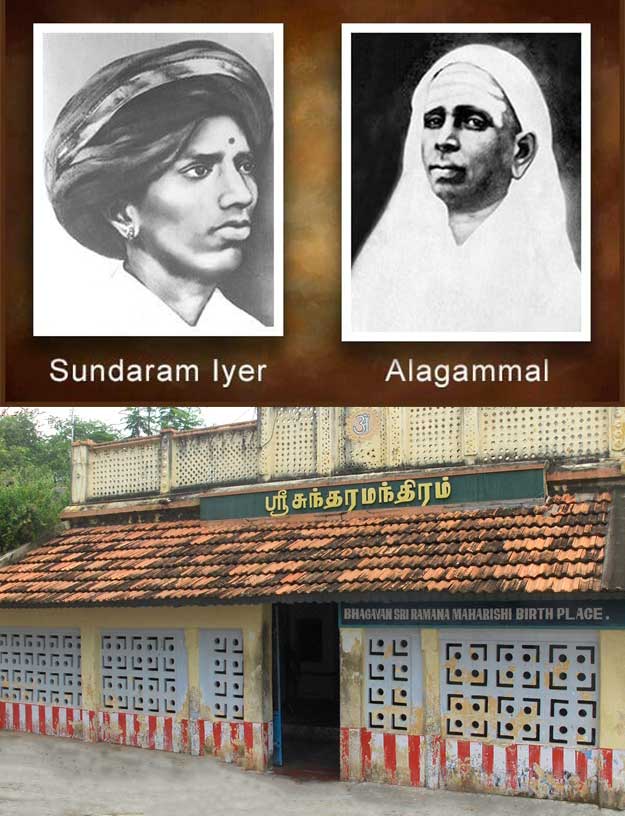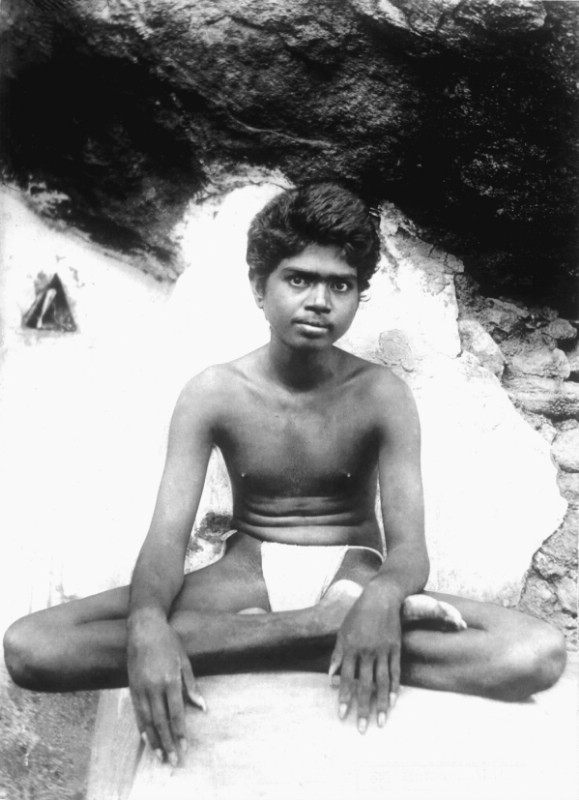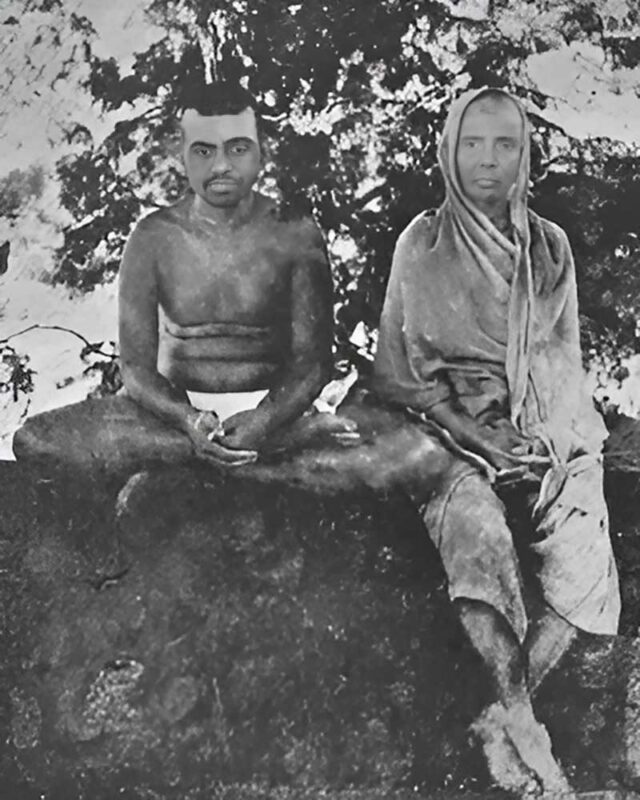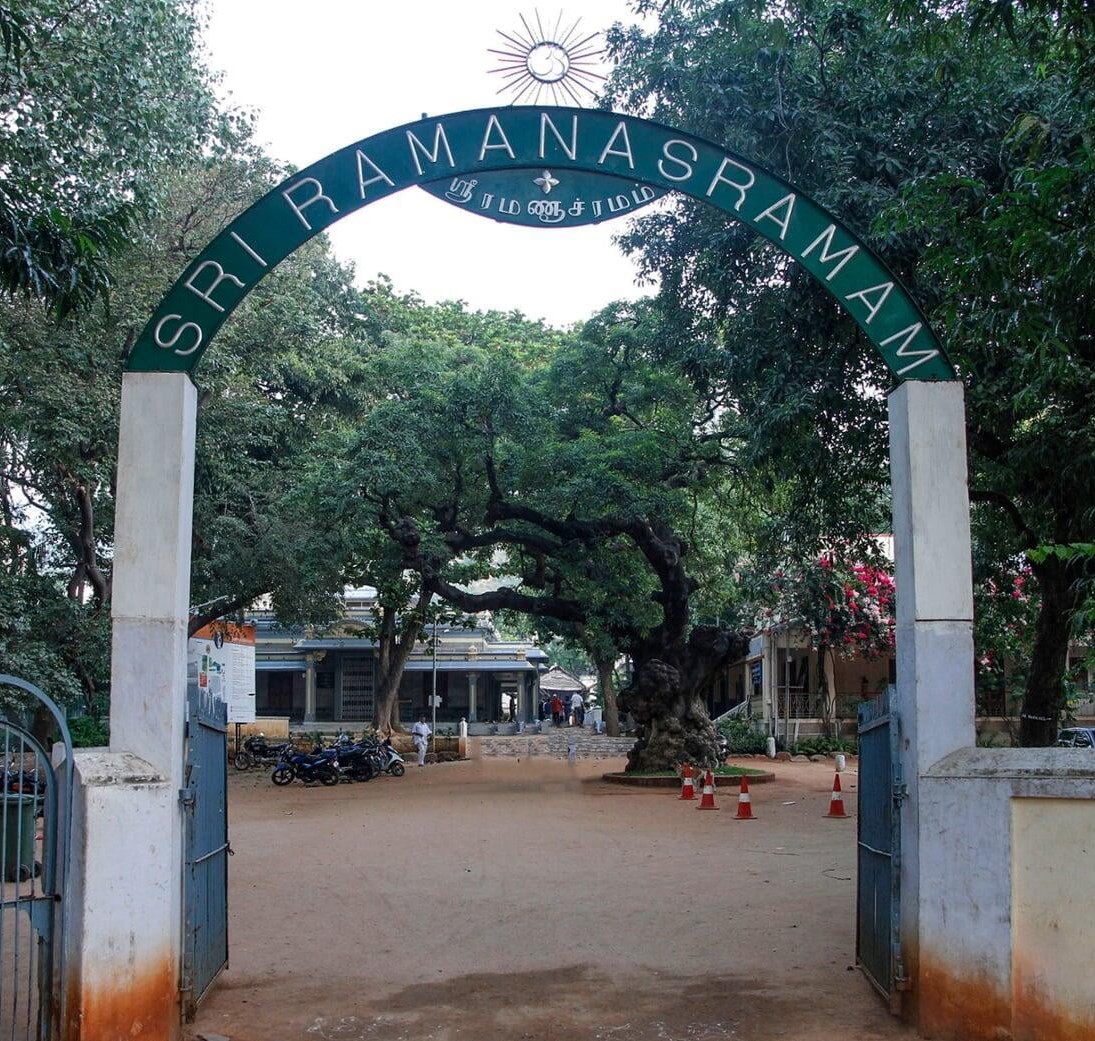ramanamaharshioffice@gmail.com
(+91) 98808 55005
ramanamaharshioffice@gmail.com
(+91) 98808 55005

Bhagawan Sri Ramana Maharshi Ashram, Home For Elders, Yoga center
HomeRamana Maharshi

about sri Ramana Maharshi
Ramana Maharshi was born Venkataraman Iyer on 30 December 1879 in the village Tiruchuzhi near Aruppukkottai, Virudhunagar District in Tamil Nadu, India. He was the second of four children in an orthodox Hindu Brahmin family. His father was Sundaram Iyer and his mother was Azhagammal. He had two brothers Nagaswami and Nagasundaram, along with a younger sister Alamelu.
Venkataraman’s early childhood was quite normal. He joined others of his age in fun and frolic. Venkataraman completed elementary school in Tiruchuzhi and moved to Dindigul for further schooling. In February 1892, his father died and the family was broken up. Venkataraman and his elder brother went to live with their paternal uncle Subbier in Madurai, while the two younger children remained with the mother. Initially Venkataraman attended Scott’s Middle School and later joined American Mission High school.
The boy preferred playing sports with his friends over his schoolwork. He had an amazingly retentive memory which enabled him to repeat a lesson after reading it once. The only unusual thing about him in those days was his abnormally deep sleep. He slept so soundly that it was not easy to wake him up.
The turning point in Venkataraman’s life came spontaneously in mid-July 1896. One afternoon, the youth for no apparent reason was overwhelmed by a sudden, violent fear of death. Years later, he narrated this experience as follows:
" It was about six weeks before I left Madura for good that a great change in my life took place. It was quite sudden. I was sitting in a room on the first floor of my uncle’s house. I seldom had any sickness and, on that day, there was nothing wrong with my health, but a sudden, violent fear of death overtook me. There was nothing in my state of health to account for it; and I did not try to account for it or to find out whether there was any reason for the fear. I just felt, ‘I am going to die,’ and began thinking what to do about it. It did not occur to me to consult a doctor or my elders or friends. I felt that I had to solve the problem myself, then and there.
The shock of the fear of death drove my mind inwards and I said to myself mentally, without actually framing the words: ‘Now death has come; what does it mean? What is it that is dying? This body dies.’ And I at once dramatized the occurrence of death. I lay with my limbs stretched out stiff as though rigor mortis had set in and imitated a corpse so as to give greater reality to the enquiry. I held my breath and kept my lips tightly closed so that no sound could escape, so that neither the word ‘I’ or any other word could be uttered, ‘Well then,’ I said to myself, ‘this body is dead. It will be carried stiff to the burning ground and there burnt and reduced to ashes. But with the death of this body am I dead? Is the body ‘I’? It is silent and inert but I feel the full force of my personality and even the voice of the ‘I’ within me, apart from it. So, I am Spirit transcending the body. The body dies but the Spirit that transcends it cannot be touched by death. This means I am the deathless Spirit.’ All this was not dull thought; it flashed through me vividly as living truth which I perceived directly, almost without thought-process. ‘I’ was something very real, the only real thing about my present state, and all the conscious activity connected with my body was centred on that ‘I’. From that moment onwards the ‘I’ or Self focused attention on itself by a powerful fascination. Fear of death had vanished once and for all. Absorption in the Self continued unbroken from that time on. Other thoughts might come and go like the various notes of music, but the ‘I’ continued like the fundamental sruti note that underlies and blends with all the other notes. Whether the body was engaged in talking, reading, or anything else, I was still centred on ‘I’. Previous to that crisis I had no clear perception of my Self and was not consciously attracted to it. I felt no perceptible or direct interest in it, much less any inclination to dwell permanently in it.”



The effect of the death experience brought about a complete change in Venkataraman’s interests and outlook. After this event, he lost interest in school studies, friends, and relations. He was absent-minded at school, "imagining and expecting God would suddenly drop down from Heaven before me". Avoiding company, he preferred to sit alone, absorbed in concentration on this current or force, and went daily to the Meenakshi Temple, and stand motionless for a long time before an image of Siva or Meenakshi or Nataraja and the sixty-three saints. He experienced an exaltation every time he stood before the images of the Saints. Tears flowed from his eyes profusely.
It was on Saturday, 29th August, 1896 Venkataraman left his home leaving a note informing the elders that he was proceeding in search of his father. He had entered into a good venture and hence no money be spent or effort made to find him. With this parting note he left Madurai for good. Arunachala’s unseen hands guided the youth to his destination.
It was the morning of September 1st 1896, three days after leaving home, that Venkataraman arrived at Tiruvannamalai station. With quick steps his heart throbbing with joy, he hastened straight to the great temple. In mute sign of welcome, the gates of the three high compound walls and all the doors, even that of the inner shrine, stood open. There was no one else inside, so he entered the inner shrine alone and stood overcome before His father Arunachala. “I have come at your call, Lord. Accept me and do with me as you will.”
Sri Ramana Maharshi stayed at various places in Tiruvannamalai and then in several caves on the Arunachala Hill until he finally settled at what came to be called Sri Ramanasramam where he lived until his Mahanirvana in April 1950. He never took formal sannyasa nor did he claim to have any disciples. From the day, he arrived in 1896 at the age of 16 until his Mahanirvana in 1950, Ramana stayed for 54 years in Arunachala and never left his beloved Arunachala.
His paternal uncle, Nelliyappa Aiyar, from Manamadurai, found him. Nelliyappa Aiyar tried his best to take his nephew along with him to Manamadurai but the young sage would not respond. He did not show any sign of interest in the visitor. So, Nelliyappa Aiyar went back disappointed to Manamadurai. However, he conveyed the news to Alagammal, Ramana’s mother. Alagammal, went to Tiruvannamalai accompanied by her eldest son Nagaswamy. Ramana was then living at Pavalakkunru, one of the eastern spurs of Arunachala. With tears in her eyes Alagammal entreated her son to go back with her, but for the sage there was no going back. Nothing moved him – not even his mother’s tears. He kept silent and sat still. A devotee who had been observing the struggle of the mother for several days requested Ramana to write out at least what he had to say. The sage wrote on a piece of paper:
The Ordainer controls the fate of souls in accordance with their prarabdhakarma [past deeds]. Whatever is destined not to happen will not happen, try how hard you may. Whatever is destined to happen will happen, do what you may to stop it. This is certain. The best course, therefore, is to remain silent.



With great regret, the mother returned to Manamadurai. Some time after this event, Ramana began living in different caves on the slopes of Arunachala. The cave where Ramana stayed the longest (17 years), Virupaksa Cave, is on the southeastern slope. During the first years on the hill, Ramana remained mostly silent. His radiance had already attracted a group of devotees around him. Not only seekers of Truth were attracted to him, but also simple people, children and even animals. The small children of the village would climb the hill to the Virupaksha cave, sit near it, play around it and then return happily. The squirrels and monkeys would come up to him and eat out of his hand.
November 18, 1907, Kavyakanta Ganapati Muni [Previously had visited Sri Bhagavan twice in 1903 & 1904] visits Bhagavan. Bhagavan imparts upadesa to the Muni. In a letter Muni wrote the next day, he declared that the Swami should be called Bhagavan Sri Ramana Maharshi
Ramana's mother returned to visit him several times. In the beginning of 1916 Algammal came back to Tiruvannamalai determined to spend the rest of her life with Ramana. A little later her youngest son, Nagasundaram followed her. Soon after his mother’s arrival, Ramana moved from Virupaksha to Skandasramam, a little higher up the Hill. Here Mother received intense training in spiritual life. She started to cook for the small group of devotees who were staying there. Nagasundaram became a sannyasi, assuming the name Niranjanananda Swami.
The Song of the Pappadum was written for the sake of the mother. The following were also written during Virupaksha days: Arunachala Aksharamanamalai, Arunachala Padikam, Arunachala Ashtakam, Translation of Devi Kalottara, Translation of Adi Sankara’s Hymn to Dakshinamurti, Guru Stuti and Hastamalaka Stotra
In 1920 the mother’s health failed and Ramana tended her with utmost care and affection, sometimes spending sleepless nights sitting up with her. The end came in 1922 and Alagammal attained liberation at the moment of death, through the effort and grace of her son. As tradition demands in the case of a liberated being, Algammal’s body was not cremated but buried. Since no burial is allowed on the Hill she was interred at its foot on the southern side. It was less than an hour’s walk down from Skandasramam, and Ramana would go there frequently, until one day he settled for good. Thus, Sri Ramanasramam came into being. He said: “Not of my own accord I moved from Skandasramam. Something placed me here and I obeyed.”
Sri Ramanasramam, situated at the base of the revered Arunachala mountain in Tiruvannamalai, Tamil Nadu, India, stands as a profound symbol of spiritual enlightenment. Founded by the esteemed sage Sri Ramana Maharshi, this sacred sanctuary has evolved into a revered pilgrimage site, drawing seekers from diverse backgrounds who are captivated by the magnetic allure of self-inquiry and the teachings of non-duality.



In 1949 it was detected that Ramana had sarcoma in his left arm. Despite intense medical care, on April 14, 1950, it was apparent that his physical end was near. In the evening, as the devotees sat on the verandah outside the room which had been specially built for Bhagavan’s convenience during his illness, they spontaneously began singing “Arunachala Siva” (The Marital Garland of Letters). On hearing it Ramana’s eyes opened and shone. He gave a brief smile of indescribable tenderness. From the outer corners of his eyes, tears of bliss rolled down. One more deep breath and no more.
At that very moment 8:47 p.m. At that moment a shooting star, vividly luminous, coming from the South (the present Nirvana Room) and moving slowly northward across the sky and disappearing behind the peak of Arunachala was observed by many in various parts of India, they ascribed this phenomenon to the passing of their Master.
Some of Ramana Maharshi's devotees regarded him to be as Dakshinamurti as an avatar of Skanda, a divine form of Shiva popular in Tamil Nadu; as an incarnation of Jnana Sambandar, one of the sixty-three Saints; and as an incarnation of Kumārila Bhaṭṭa, the 8th-century Mimamsa-philosopher.